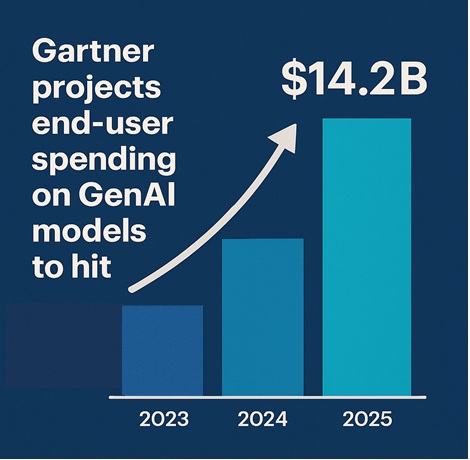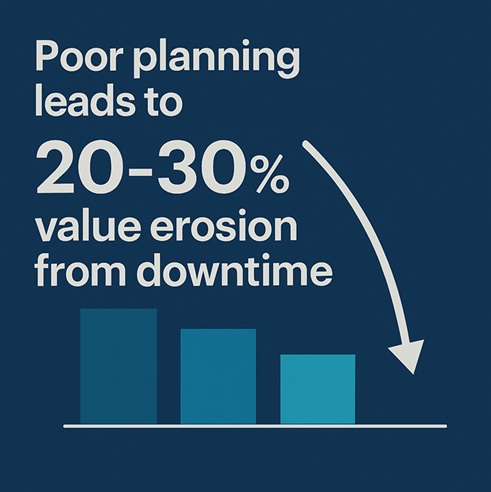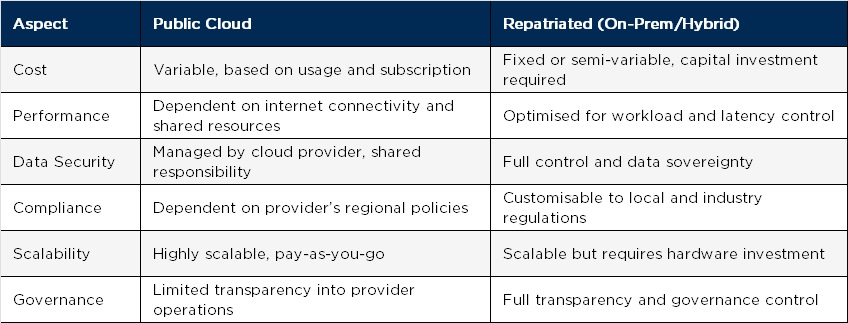Data ownership as a fundamental safeguard against risks, an economic imperative for cost efficiency, and a regulatory baseline for jurisdictional compliance reveals how these trends are reshaping enterprise strategies amid rising AI demands, regulatory pressures, and economic realities.
We compiled the latest 2025 insights on the dynamics of data repatriation and sovereignty from vendors such as Exasol, Kyndryl, and Pulsant, alongside broader analyses from Gartner, Veeam, and Flexera, and real-time discussions across web resources and platforms like X.

Introduction
Data repatriation is a deliberate migration of data and workloads from public cloud environments back to on-premises, private, or hybrid infrastructures. This trend is based on several essential needs:
- Data ownership: controlling data’s physical and logical location mitigates risks such as unauthorised access, vendor lock-in, or breaches that could expose sensitive information.
- Economically, it addresses imperatives such as optimising costs, as cloud expenses driven by egress fees and unpredictable scaling can erode profitability.
- Regulatory basics further underscore this: jurisdictional control ensures compliance with local laws, preventing violations that lead to fines or operational shutdowns.
Data sovereignty is a principle that data should remain under the governance of its originating jurisdiction, emphasising control over location, access, and usage to uphold privacy and security. This concept closely aligns with repatriation, as sovereignty concerns, such as those heightened by geopolitical tensions or stringent privacy laws, often drive the decision to “bring data home.” For instance, when data resides in foreign clouds, it may fall under conflicting regulations, risking non-compliance; repatriation restores alignment with local mandates.

These trends are accelerating in 2025 due to converging factors:
- exploding AI-driven costs,
- hybrid cloud maturation, and
- evolving regulations.
Recent data highlights this shift. A Barclays CIO survey from 2024 indicates that 83% of enterprises plan to repatriate workloads from public to private/on-premises environments, up from 43% in 2021, primarily due to AI costs and sovereignty. Similarly, Kyndryl’s 2025 reports note that AI expenses and sovereignty are prompting enterprises to repatriate data to regional or on-premises. Gartner forecasts that over 50% of multinational organisations will adopt digital sovereign strategies by 2029, up from less than 10% today, reflecting a projected surge in sovereignty-focused. On X, discussions echo this urgency, with users like @WiFiHockey highlighting APAC’s lead in repatriation due to public cloud security concerns.
This acceleration positions 2025 as a pivotal year in which enterprises must balance innovation with resilience, potentially reshaping global data flows and economic models.
Data Repatriation
Data repatriation is evolving beyond a mere “cloud exit” into a strategic recalibration, driven by needs for ownership and economic efficiency. Trends emphasise hybrid architectures that blend public cloud flexibility with on-premises control, optimising for AI workloads, sustainability, and performance.
One prominent trend is the shift toward hybrid architectures for cost control. Enterprises are grappling with “bill shock” from cloud egress fees and unpredictable scaling, especially as AI models demand massive compute resources. Flexera’s 2025 State of the Cloud Report reveals that 84% of organisations struggle with cloud spend management, with repatriation emerging as a key mitigation strategy. Kyndryl’s insights underscore how sovereignty concerns compound this, driving repatriation to private setups where costs are more predictable. Pulsant declares 2025 “the year of repatriation,” citing potential export tariffs on US-based data transfers that could further inflate expenses.

AI workload optimisation is another driver. With AI costs soaring, organisations are repatriating compute-intensive tasks to on-premises for better latency and control. Equinix notes “cloud rebalancing” for AI development, placing critical workloads where they perform best.
Sustainability demands are rising, as energy-intensive AI clashes with corporate ESG goals. InfoWorld’s 2025 cloud trends report highlights repatriation’s role in reducing carbon footprints by enabling more efficient on-premises data centres. Performance enhancements round out the trends, with repatriation enabling lower latency for edge applications.
Data from Help Net Security shows 97% of mid-market organisations are planning partial repatriation, signalling widespread adoption.
Data Sovereignty
Corporate data sovereignty is a company’s ability to fully control, manage, and oversee its data in accordance with its business objectives, legal requirements, and ethical standards. This includes ensuring data security, preventing unauthorised access, compliance with legislation and regulations, data localisation, and maintaining independence in decisions regarding data storage, processing, and transfer. Key characteristics also include autonomous data management, transparency and traceability, adaptability and resilience, and the ethical use of data.
Data sovereignty builds on regulatory basics, emphasising jurisdictional control to prevent compliance violations while enabling secure innovation. Trends include a global push for localised data, distributed AI privacy infrastructures, evolving regulations, and sovereign clouds.
The EU AI Act, effective in phases from February 2025, ties AI governance to GDPR, mandating high-quality datasets and restricting cross-border transfers for sensitive data. This fuels localised storage, with Exasol’s 2025 trends report highlighting compliance challenges and resilience strategies. Globally, data localisation mandates are proliferating; Cisco’s 2025 Privacy Benchmark Study notes rising interest in sovereignty amid localisation drives.
Distributed infrastructures for AI privacy are gaining traction. Equinix emphasises setups that keep data within borders while supporting AI, addressing privacy in generative models. Evolving regulations on sensitive data, like stricter enforcement under GDPR and new laws in Asia, demand zero-trust architectures. Dataversity’s 2025 governance trends stress real-time frameworks and high-quality data for AI ethics.
The rise of sovereign clouds is transformative. Veeam’s 2025 predictions forecast increased repatriation to hybrid models for sovereignty, with adaptable strategies optimising access.
Challenges for C-Level Executives
CxOs in 2025 face strategic hurdles rooted in the following tensions: balancing economic imperatives with regulatory demands while securing ownership in AI-driven environments. These challenges can erode value through downtime, fines, or lost opportunities.
- Balancing cost overruns from cloud migrations with repatriation investments: Public cloud “bill shock” from AI can reach millions; repatriation requires upfront capex but promises long-term savings. Hypothetical: A multinational retailer migrates AI analytics back on-premises, avoiding $5M in annual egress fees but facing $2M initial setup. Poor planning leads to 20-30% value erosion from downtime, according to TechTarget.
- Navigating regulatory complexities: Data localisation laws (e.g., EU AI Act) create conflicts for multinationals. Example: A global bank repatriates data to comply with GDPR but struggles with varying Asian mandates, risking fines up to 4% of revenue. CIO Influence notes this as a top hurdle in cloud strategy.
- Addressing security and privacy risks in AI-integrated environments: Vendor lock-in and cyber threats amplify with AI; breaches could expose sovereign data. Hypothetical: An energy firm using distributed AI faces ransomware, delaying operations. Veeam predicts ransomware evolution will heighten this in 2025. Learn more about the potential breaches in the article: GenAI Without Governance is Exposure: The Universal Semantic Layer.
- Overcoming organisational resistance to change, skill gaps in hybrid management, and sustainability pressures: Internal pushback and talent shortages hinder transitions; AI’s energy demands clash with ESG goals. Example: A manufacturer repatriates for sustainability but faces skill gaps, per Equinix, which delays AI deployments.

Strategies and Recommendations
CxOs should prioritise ownership through governance, economic efficiency via hybrid models, and regulatory compliance through tools. Actionable advice includes:
- Adopt multi-cloud hybrids: Blend public and private for flexibility, per Gartner’s forecast that 90% of organisations will hybridise by 2027.
- Invest in observability: Tools for real-time monitoring, as Dataversity recommends for AI ethics.
- Prioritise data governance: Frameworks like zero-trust, with Exasol’s resilient solutions for sovereignty.
Forward-looking: Integrate DePIN (Decentralised Physical Infrastructure Networks) for decentralised privacy, enhancing sovereignty without central vulnerabilities. Predictions suggest DePIN adoption will surge by 2029, in line with broader trends.
Conclusion
Data repatriation and sovereignty in 2025 hold transformative potential, turning regulatory and economic challenges into opportunities for resilience and innovation. CxOs can lead proactive shifts, fostering secure, cost-effective ecosystems that empower enterprises amid AI’s rise. As Gartner and others predict, those who embrace sovereignty early will define the next era of global data governance.
The imperative is clear. Act now to own the future!
For more information on how to tackle these challenges, contact us today.
Read more
The Turning Point: Data Repatriation and Digital Sovereignty in 2025
The year 2025 is emerging as a turning point. AI costs are rising faster than most enterprises can manage, regulatory pressures are growing more complex, and th...
Read moreThe Universal Semantic Layer – The Key to Data Security and Usage Compliance
For organizations aiming to master a data-intensive world In an era where artificial intelligence (AI) and its agents are becoming critical to business success,...
Read more

